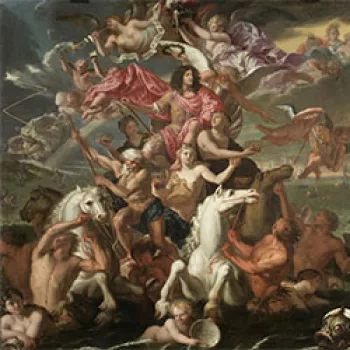Cabinet, previously known as the 'Warwick Cabinet' or the 'Coronation of James II Cabinet' c. 1650 - 1690
Ebony, tortoiseshell, ivory, silver, silk velvet | 197.0 x 98.7 x 50.5 cm (whole object) | RCIN 21633

Mathieu van Beveren (1630-90)
Cabinet, previously known as the 'Warwick Cabinet' or the 'Coronation of James II Cabinet' c. 1650 - 1690

Mathieu van Beveren (1630-90)
Cabinet, previously known as the 'Warwick Cabinet' or the 'Coronation of James II Cabinet' c. 1650 - 1690

Mathieu van Beveren (1630-90)
Cabinet, previously known as the 'Warwick Cabinet' or the 'Coronation of James II Cabinet' c. 1650 - 1690

Mathieu van Beveren (1630-90)
Cabinet, previously known as the 'Warwick Cabinet' or the 'Coronation of James II Cabinet' c. 1650 - 1690





-
A tall, narrow, red tortoiseshell and ebony cabinet mounted on a square inlay top, with two front panels concealing an architectural stage-set interior on a red velvet background, consisting of a domed chamber with columns to the sides, richly decorated with ivory carvings and figures depicting James II crowned, seated on his throne with an elaborate canopy above, flanked by two allegorical figures representing Wisdom and Strength, with an allegory of Peace presenting a laurel to their left, surrounded by putti holding garlands and shields, the whole surmounted by an ivory figure of St George and the dragon at the top and with three silver figures of lions at the base. The cabinet stands on four legs joined by turned stretchers, the back legs turned, the front legs each embellished with a carved ivory scroll mount terminating in claw-on-ball feet resting on square blocks, all legs raised on bun feet.
The illustration of the cabinet in Plate 19 of G J Richardson's Studies from old mansions published in 1842 reveals that some of the decoration has been lost, in particular two trumpets from the hands of two putti, a sceptre held by another putti, and an Orb from the cushion held by Wisdom and Strength is also missing.
The lance held by the figure of St George is not an original but a later replacement.
The precise circumstances and purpose of the creation of this cabinet are difficult to divine. Although the composition is that of a funerary monument, it cannot have been made after James II's death in 1701. The representation of the crowned sovereign enthroned amidst naval and maritime devices, supported by Strength and Wisdom and with Peace proffering a palm, points towards the signing of a victorious treaty to conclude a naval war. The naval iconography is generally appropriate for the long-serving and successful Lord High Admiral, a post held by James as Duke of York from 1660–73 and as king from 1685–88. If the seated king is correctly identified as James II (which on the grounds of likeness seems acceptable), then a narrow period of five years (between the accession of James II and the death of van Beveren) can be supposed for the creation of the sculpture.The curious motif of a double crowning, whereby the two supporters hold a crown (identifiable as St Edward's Crown, made in 1661 for Charles II) over the king, who already wears a crown of state, is unexplained. The fleur-de-lis carved on the back of the canopy has suggested a theory that the object was made for presentation to Louis XIV and a third crown, now missing from the cushion below the king, was thought to represent the ancient crown of France.
Whilst in general the figures and other carved ivory elements have a stylistic homogeneity, the outsize group of St George and the dragon at the top is clearly of different origin, and inferior quality. Its tortoiseshell plinth and waved moulding are also quite distinct in style from the rest of the cabinet except for the oversized cornice. The three silver lions at the base of the structure are also by a different hand. In the 1818 sale catalogue the cabinet was described as of tortoiseshell and ebony, but there was no mention of the stand, which for such an eye-catching object is suspicious. The front legs were almost certainly made in India for a substantial throne-like chair, and the present configuration is highly suggestive of an antiquarian confection of around the 1830s.
Text adapted from the catalogue entry for Charles II: Art & PowerProvenance
The cabinet was purchased for the Royal Collection in June 1937 by Queen Elizabeth (later Queen Elizabeth The Queen Mother), consort of King George VI, and sent to Windsor Castle. It is first recorded in an illustration in GJ Richardson's Studies from old mansions in 1842 (Plate 19). Exhibited at Worcester Fine Art Exhibition 1882.
-
Creator(s)
(ivory carver)(nationality)(nationality)Acquirer(s)
-
Medium and techniques
Ebony, tortoiseshell, ivory, silver, silk velvet
Measurements
197.0 x 98.7 x 50.5 cm (whole object)
Category
Object type(s)
Alternative title(s)
Carved allegorical group of James II enthroned
Previously known as the 'Warwick Cabinet'
Previously known as 'Coronation of James II Cabinet'








